Overview of armored transporters and infantry fighting vehicles (Part of 3)
Havoc is a direct heir to the Finnish armored modular machine Armored Modular Vehicle and has identical dimensions with it. Sales of AMV vehicles to seven countries, Finland, Poland, Slovenia, Croatia, South Africa, the United Arab Emirates and Sweden have reached 1400 units. The first vehicles were manufactured in the 2004 year, and for the first time, an AMV rapid deployment occurred in the 2007 year in Afghanistan, where to date this vehicle is in service with several contingents. AMV is designed in such a way that it has an optimal modularity of components and adapts to a variety of options without changing the basic design. The AMV machine has protection against armor-piercing sub-caliber shells of caliber up to 30 mm in the anterior sector and the bottom protection against IEDs, attack nuclei, and high-explosive mines up to 10 kg.
The various options are based on two chassis lengths, respectively, 7,7 and 8,2 meters, while the width and height of them are the same, respectively 2,8 and 2,3 meters. Both chassis are available for all developed options. The base model provides a platform for the variants of the BTR, BMP, BREM, command, sanitary, reconnaissance, and ATGM conveyor. A model with a raised roof provides additional space in the rear of the vehicle for commander, reconnaissance, sanitary options and a workshop. The heavy weapons platform was optimized for the installation of large-caliber weapons systems, such as the 105-mm gun (MGS), as well as for the installation of the Patria Nemo 120-mm mortar. In March, 2013, Patria supplied the Swedish army with the first 113 AMV vehicles of the latest generation.
In 2012, Patria, the Ministry of Defense of Slovenia and Rotis Plus signed a final agreement regarding the Slovenian AMV contract. Due to the first deliveries, the AMV fleet of machines has already been created, consisting of Svarun 30 machines, the remaining supplies will bring the total number of machines to 135.
Things are much better in Poland, this country announced in July 2013 of the year that another Rosomak 307 BTR will be manufactured within five years. Poland also expanded production and sales rights for this machine for another 10 years, and here Africa is one of the target regions. In Poland, the Rosomak machine is manufactured at Wojskowe Zaklady Mechaniczne.
In February, 2013 in South Africa, the Minister of Defense signed a contract for the Hoefyster machine (Badger), but the Agency for Technology and Procurement transferred this contract to Denel only in September of that year. Its cost is 680 million euros, it provides for the production of 238 machines in five different configurations. Mainly based on the Patria AMV chassis, the Badger will, however, be characterized by numerous design changes to meet local needs. Among them, mine protection with a flat bottom based on Flat Floor technology from Land Mobility Technologies (by the way, the same company is responsible for the new interior). Other locally produced equipment will also help increase the national component of the project; the car is assembled in South Africa by Denel Land Systems, which will also provide a two-seat tower for the fire support option.
The new machine in the 8 × 8 configuration is currently known as the New Vehicle Concept - the concept of the new car (the real name will apparently be revealed on the Eurosatory 2014), the newcomer is not too different at first glance from the basic model (see photo at the beginning of the first part) . Nevertheless, the Finnish company sees it as a completely new car, although there are not so many technical details. First, the car got a little longer, the 8,4 meter versus the original 7,9 meter; the net weight remains of the order of 17 tons, which implies the use of modern materials with improved characteristics. The total weight increased to 30 tons versus 27 tons in AMV, the usable payload is 13 tons. Mobility has been improved thanks to an improved suspension and a new power unit. The powertrain transmission was modified to cope with the new six-cylinder in-line engine rated at 450 kW (instead of the original 405 kW) and high torque. Engine type is not specified, but must be from the DI 12 family of Scania Diesel. The maximum power reserve is increased from 800 to 1000 km, which is a consequence of the increased fuel tank capacity and better efficiency of the new engine.
The reservation kit supplied by IBD Deisenroth must be adapted to the buyer's needs according to the modularity concept underlying the Patria philosophy. The driver has a full overview of 180 ° thanks to five periscopes from GUS; they are installed in such a way that they guarantee better protection if the projectile hits at high elevation angles. The vehicle can carry a crew of three people plus 10 paratroopers who embark and disembark through the stern ramp. The new car is floating, it is equipped with a modern generator on the 530 ampere, which will be able to provide in the future growing appetites of electrical systems. The prototype shown at DSEI has already passed a series of tests that the company did not want to describe. A remote-controlled Saab Trackfire combat module, armed with an 25-mm cannon and a 7,62-mm machine gun, is installed on the machine. According to the company Patria, the new machine will be able to adopt weapons up to the caliber 120 mm, as mortars for firing indirect fire (for example, Patria Nammo), and guns for firing direct fire with high pressure in the chamber. Representatives of the company stressed that the emergence of a new car will not mean that AMV will disappear from the company's product line.
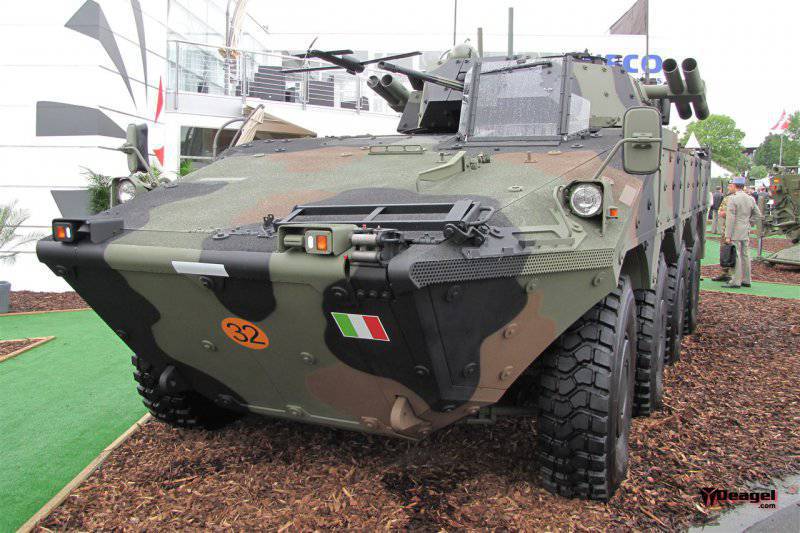
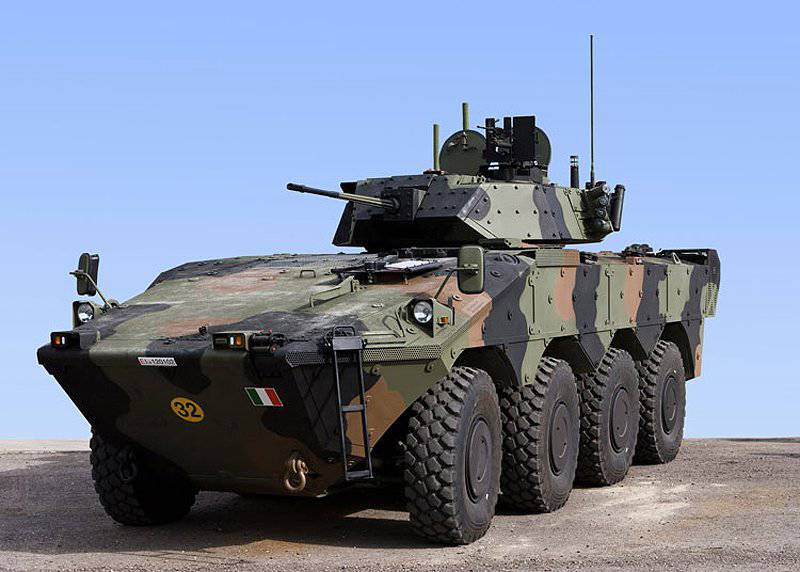
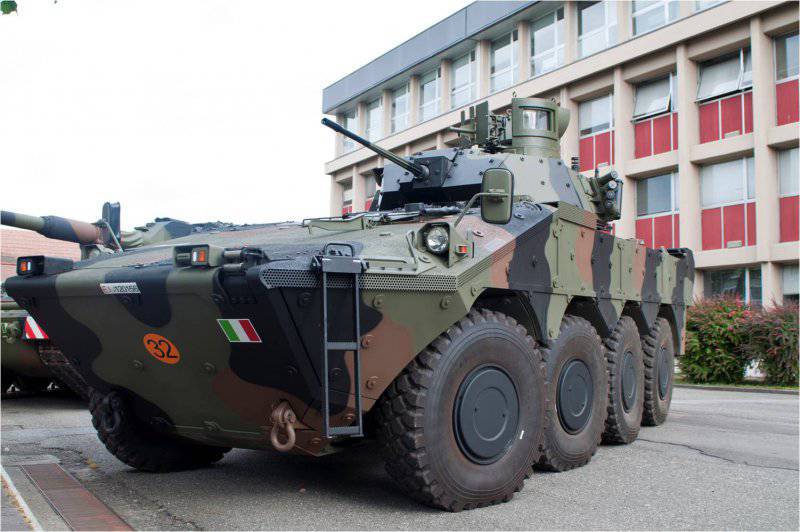
The Italian army gets the third batch of the Freccia program, which will arm the first middle brigade "Pinerolo"
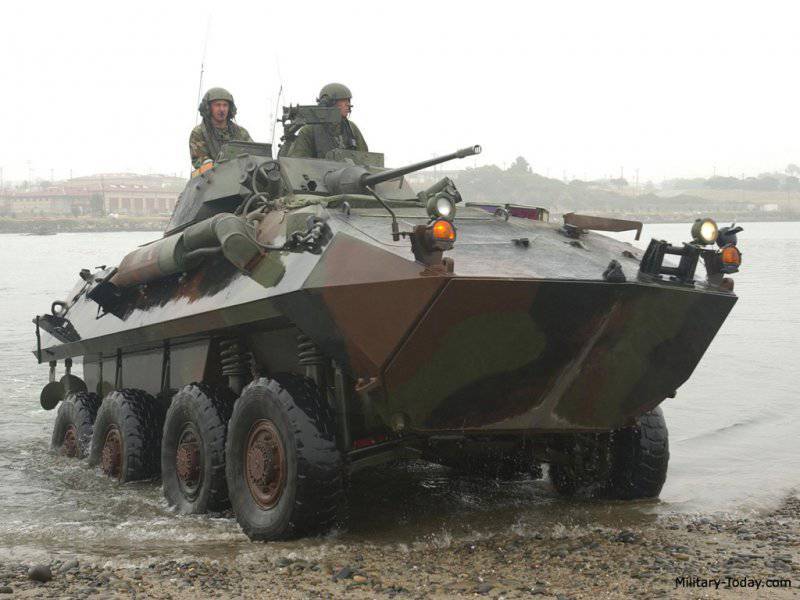
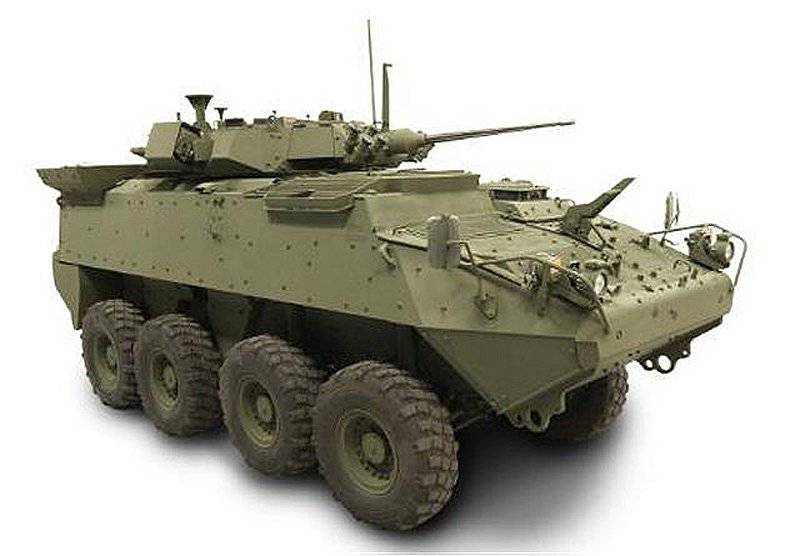
General Dynamics Land Systems Canada is constantly modernizing the LAV fleet, increasing the levels of protection for these machines while maintaining the same mobility
Italian way
The floating VBA car (Veicolo Blindato Anfibio), from which the Marine Personnel Carrier version originates, is currently undergoing qualification tests in Italy (the first two photos in the first part). The first phase of development ended in December 2012 with a demonstration of the amphibious capabilities of the machine to the Italian Defense Ministry. VBA is a general offer from Iveco DV and Oto Melara for a floating BMP equipped with a Hitfist module. The chassis without the established armament saves the name SuperAV.
The VBA's undercarriage is heavily connected to the Freccia VBM, an 8 × 8 army vehicle that has shown operational readiness of over 90 percent in its two and a half years of service in Afghanistan. However, the power unit for VBA is different and is based on the finished Cursor 13 engine mounted on Iveco trucks. The first sensation of a passing car is a significantly reduced acoustic signature. The engine also rotates two screws in the nozzles located in the rear of the machine, which allow you to reach a speed of 5,4 knots afloat. In order to reduce the mass, the capsule of the crew and passengers is limited in width, but hinged elements are attached to it, providing additional protection from the VCA and buoyancy and giving the machine its distinctive shape. A double anti-mine V-shaped sheet with the use of nanomaterials is used to protect the crew and the landing from undermining under the bottom. The Oto Melara turret was formerly armed with an ATK 30mm cannon, although the Italian army chose the 25mm option for standardization reasons. On the day of the presentation, the sea was calm, although on the previous day you could become witnesses to the behavior of the car when the sea was rough 2 - 3 points (up to 1,25 m). At the entrance to the sea, the car fought with the waves until it reached a depth of 2,6 meters. Then the screws and the nose came into operation, which allowed to increase the melt speed to the value necessary for Italian the fleet.
In the MPC version, the tower was replaced by the Crows II module, and the length of the vehicle was extended to 8,1 meters versus 7,92 meters in VBA. The width increased by 5 cm, and the height by 30 cm, reaching the 2,6 meter in order to meet 95 percent of the requirements of the Marine Corps. The height also increased, partly because of the new wheels, since the 16.00R20 wheels were installed on the MPC instead of the 14.00R20 wheels on the VBA. The MPC is equipped with an Iveco Cursor 13,6-L engine with turbocharging and intercooler with an HP 560 power.
As already noted above, the VBA car made full use of the operating experience of the Freccia infantry fighting vehicle obtained in Afghanistan by the first medium brigade of the Italian army from 2010 of the year; two of its three infantry regiments are now fully equipped with these 8 × 8 BMPs. Currently, about Freccia 223 machines are ordered and divided into three batches. The Iveco DV consortium - Oto Melara (CIO) delivered the 50 plus 71 to the Freccia machine in the combat version in the first two installments, as well as the 24 anti-tank installations, which are based on the combat version, but have Spike ATGM launchers on each side of the tower. The mortar conveyor variant with the Thales 2R2M mortar set with an 120-mm rifled barrel is currently undergoing qualification, and the CIO consortium expected to deliver all the 12 machines ordered by the end of the 2013 year.
This industrial consortium has analyzed the variant of the command post, in early June it was not yet approved, since some refinement was needed for the installation of new radio stations. The Italian army decided several years ago to change its concept of a command post, breaking it between a command variant based on a classic turretless chassis of the same height as a combat vehicle, and a tactical version that would look like a standard combat vehicle, but equipped inside with a command post with three operators.
In June, 2012 of the year a third-party contract was signed, providing for the supply of 51 combat and 11 anti-tank vehicles, as well as spare parts for the conversion of two vehicles that CIO sent to Russia for testing. One of them was equipped with a standard Hitfist 25 turret, but lacked radio stations, a battle management system, and additional armor, while the second machine had a Hitfist 30 Overhead Weapon Station combat module installed - an uninhabited version of the Oto Melara tower. An additional contract is in the process of implementation, it provides for the modernization of cars from the first and second installments of new programmable radio stations, VU silencers of the newest generation, new on-board computers and a system of situational awareness of the circular review. A logistics package is also included in the contract. In order to replenish three infantry regiments and the headquarters battalion of the middle brigade "Pinerolo", another batch of vehicles is needed; it must include 18 command posts and 8 mortar installations and may also include the development and prototype of an intelligence variant.
The CIO consortium also proposed an evacuation vehicle and an engineering vehicle, but apparently the American army is not considering these options yet. The total cost of the machines for the first brigade, funded by the Ministry of Economic Development, will be approximately 1450 million euros, in line with the initial forecast of another year's 2005. Obviously, CIO is counting on the export market. The financial situation in Spain most likely forced the army to abandon plans to acquire armored infantry fighting vehicles 8 × 8. The company offered a leasing scheme, but it was also rejected. Australia and India are considered among the priority customers. The Australian Land 400 program worth 10 billions of dollars includes roughly 600 wheeled and tracked vehicles. In this regard, the CIO consortium is looking for ways to cooperate with local companies. The initial demand for India is about 100 machines, the competition is considered to be very open, although if the application is based on price, then European companies may face great difficulties here.
The Nuova Blindo Centauro (the new Centauro armored vehicle), also known as the Centauro 2, is based on the well-known Centauro vehicle with the H-drive drive circuit (the power flow from the engine is distributed into two parallel streams along the sides of the vehicle). This machine is designed to provide direct fire with new medium-sized brigades and is equipped with an Oto Melara Hitfact 120 turret, armed with a new lightweight, smooth-bore 120-mm cannon. The first contract worth 1,5 million euros, signed in 2010, allowed Iveco to develop an 20-liter V8 Vector engine. It is a modified power plant of a diesel locomotive, which was brought up to military standards and equipped with a common fuel line. New engine power 720 hp (this will give the specific power of the 24 hp / t) is completely ready for today. The Defense Ministry signed a second contract, according to which half of the development of New Centauro will be financed, the remaining half is funded by the CIO (the ministry’s money is allocated in stages). Prototype delivery is expected in 2014 year, and the first production machine in 2016 year, all 72 new Centauro machines for three regiments (one for each medium brigade) will be delivered by 2018 year.
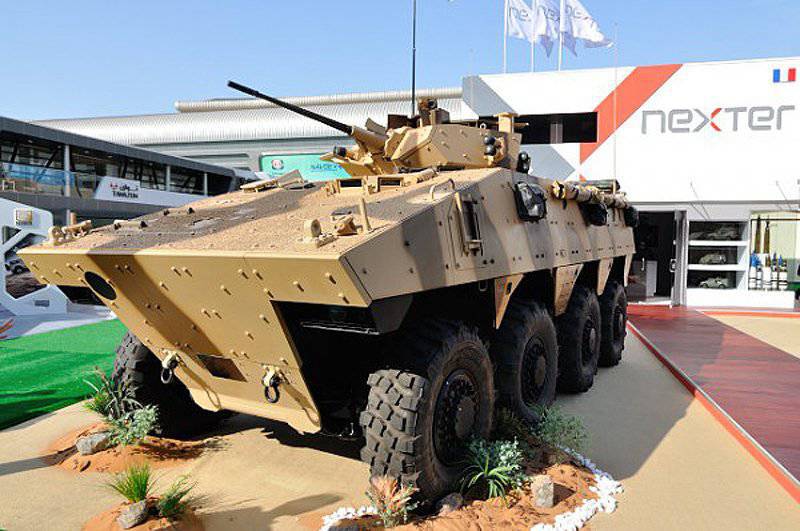
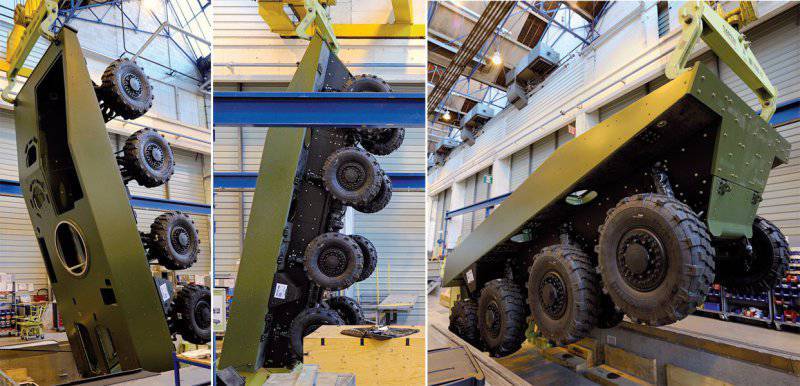
Nexter VBCI - at the exhibition and the manufacture of the machine body (below). BMP 8 x 8 is in service with the French army in Afghanistan and is in search of the first export contract
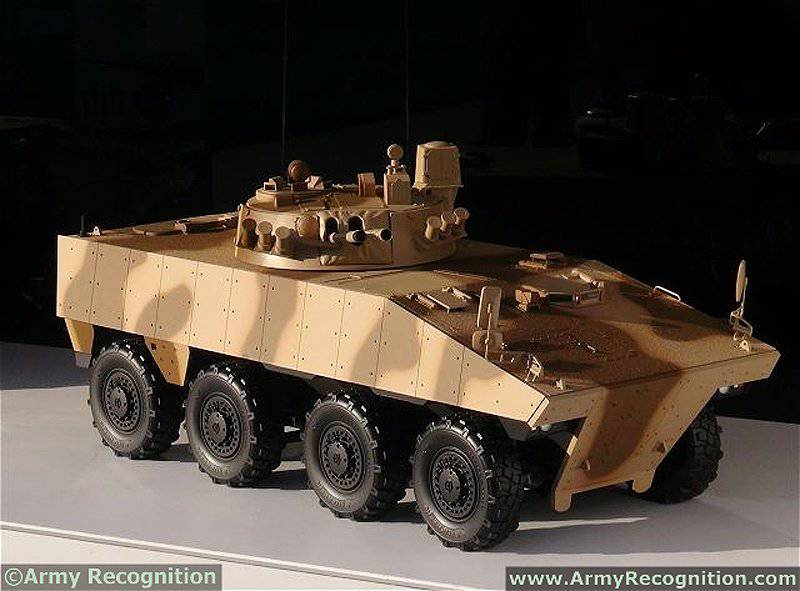
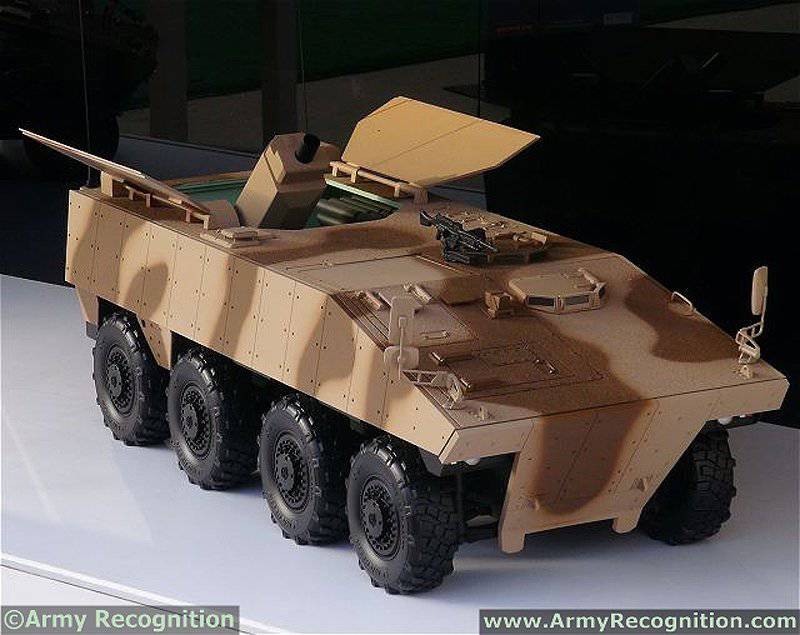
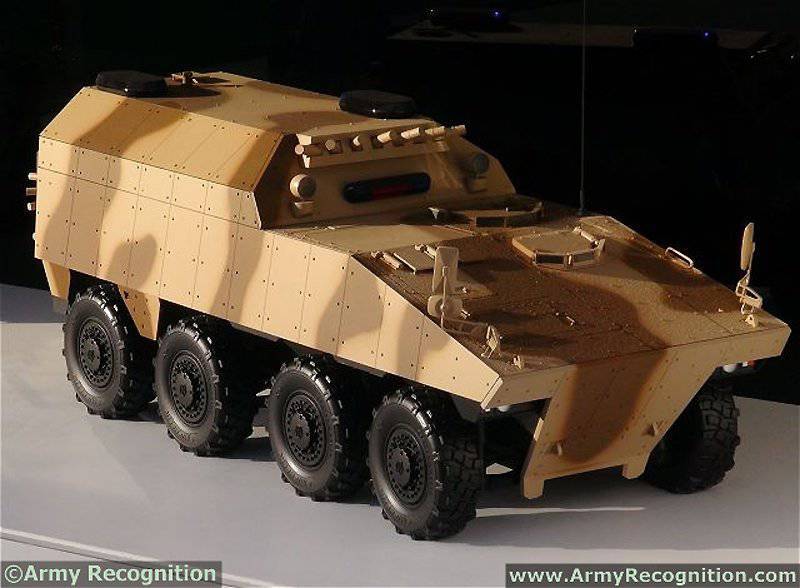
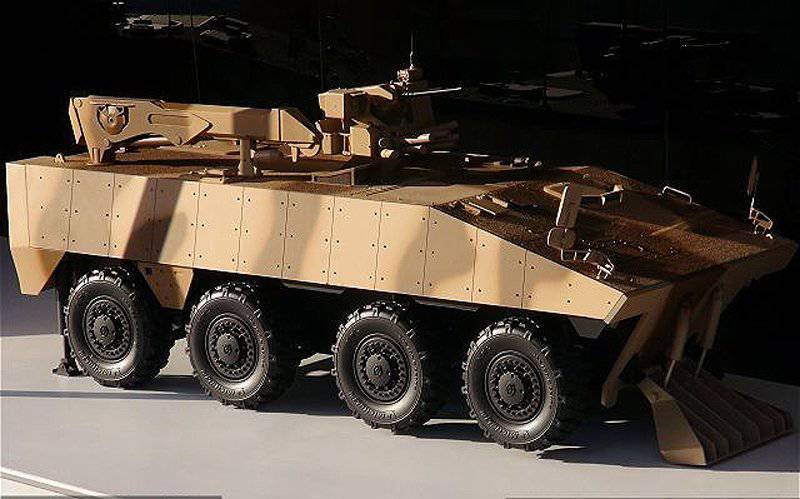
Nexter plans to add various versions of its VBCI car to the current variants of the BMP and the command post: top down BMP model with Eastern European weapons, mortar model, sanitary version, evacuation vehicle model
Piranha, LAV & Co
Although the details of the GDLS and GDELS offerings are not represented under the American Marine Corps MPC program, the wheeled vehicle family from these firms makes its way through several competitive bids. The Canadian GDLS Canada offers the Piranha 5 for the CCV program with the Rheinmetall Lance Modular Turret modular turret installed, armed with an 30-mm cannon. The Piranha 5, equipped with a lighter ABS, is also offered by GDELS to replace the Danish fleet of BTR M113. To this end, GDELS has teamed up with the Danish company Falck Schmidt Defense Systems, which has considerable experience in modernization and overhaul, and which could assemble machines without any problems.
At the end of January 2013, GDLS Canada delivered the first upgraded Canadian Army Light Armored Vehicle III light armored vehicles. A total of 550 plus 66 machines will be brought to this standard, the latest 66 machines are designed to enhance intelligence and surveillance capabilities.
A week earlier, GDLS Canada received a contract worth 24 million dollars for the production of 13 new LAV-A2 for the Marine Corps. The corps ordered a total of 253 of such machines, which will join the family of more than 800 first-generation LAV machines that have been in service since 80's. January 2013 of the year was the harvest month for GDLS Canada, as the contract for the Colombian army 24 LAV machines was also signed. Purchased vehicles are the newest standard - this is a variant of the LAV III with a double V-shaped hull and additional armor. They will be equipped with the Rafael DBMS and deliveries must be completed by May 2014.
Russia is a new French collection.
Very briefly, since the cooperation on this project is suspended
In February, 2013, the company Uralvagonzavod and Renault Trucks Defense began the joint development of the 8 × 8 configuration machine in order to replace the numerous armored personnel carriers in service with the Russian army. The model of this machine under the wonderful name Atom 8 × 8 was shown in September 2013 of the year at the exhibition Russian Expo Arms in Nizhny Tagil. The total mass of the Atom 32 is tons, the machine has a length of 8,2 meter, a width of 3 meter and a height of 2,5 meter. The power unit consists of a Renault diesel engine with a power over 600 HP. and automatic transmission, the specific power of the machine is more than 18,7 hp / t, it is equipped with independent suspension, has a maximum speed of 100 km / h and has a cruising range of 750 km. A kit for the water is available. The machine is equipped with a stern ramp and four hatches and accommodates a maximum of two crew members and 10 paratroopers in the BTR variant armed with a remote-controlled combat module with an 12,7-mm machine gun, while the BMP version with a double turret with an 57-mm gun carries up to 8 infantrymen. The modular anti-aircraft gun is also armed with a 57-mm gun and has a crew of three people. These two companies are considering the development of a command post, engineering and sanitary options, as well as self-propelled howitzers armed with an 120-mm gun. The ballistic protection of the machine has been brought to the 5 Level, but no details have been made public on mine protection, except for the ground clearance of an 0,6 meter. The Atom machine can be transported on Il-76 and An-124 aircraft. Two companies estimate the potential of the Russian market at about 2000 machines.
Frenchman tested in battles
While many VBCI machines are operating in the French contingents in Afghanistan, Lebanon and Mali, the General Directorate of Arms adopted 2013 of the 500 machines ordered by 630 in June. It is important that, starting in January 2013, the machines are supplied with the Félin kit. The machine is built and manufactured by Nexter, and Renault Trucks Defense (RTD) supplies the undercarriage components. Currently, VBCI has proven itself in its current configuration. Although the car was developed according to French specifications, Nexter decided to optimize its characteristics and cost in order to create greater attractiveness of the car in the international market and at the beginning of 2011, they launched their plan “Le Grand Large” in order to reduce the cost of the company's products by 25%. Thus, the VBCI machine became the object of a thorough audit in order to give customers exactly the capabilities that they needed, while avoiding unnecessary performance, and at the same time optimizing the cost throughout the chain of subcontractors, including some modernization work, in order to achieve desired results.
According to representatives of Nexter, the VBCI is currently competitive in terms of development time and running costs. But in the meantime, the car gradually gets heavier. The current VBCI machines have a mass of 29 - 30 tons, although the machines that are currently being tested and offered in various applications have already passed the 32 ton mark. This makes it possible to increase protection, for example, by obtaining 4a / b Level mine protection (lessons from Afghanistan), as well as to increase the payload capacity in order to install heavier towers. The French army is already considering upgrading parts of its fleet, for example 100 - 200 machines, and a decision on this issue was expected at the end of 2013 - the beginning of 2014. The machine weighing tons of 32 passed a three-week test in the desert. The chassis components remain largely unchanged, the 550 horsepower engine, as well as the axles and transmission remained intact except for a shorter final drive, which will reduce the maximum speed. The export version is equipped with the OpSys on-board electronics architecture, an all-view situational awareness system, and a video signal is also available on the display in the troop compartment. Regarding power generation, Nexter considers the current output to be sufficient for today's needs and does not consider any short-term modernization. Two years ago, the 32-ton version was qualified and has since been shown to some potential buyers, such as Canada and Denmark.
Canada, Nexter offered its own solutions for improved ballistic and mine protection for the entire machine. The need is 108 machines plus an option for another 30 units. If successful, bоMost of the work will be done in Canada, since Renault Trucks Defense is going to start production there through a company within the Volvo group.
In Denmark, they initially expect to get 206 machines with real numbers above 360 and the maximum number of 450 machines. If successful, 50% of the scope of work will be performed in France.
As for the United Arab Emirates, the numbers are much higher, the unconfirmed planned number is approximately 700 machines and their partial production will be arranged at the local plant.
The UAE is not the only purpose of Nexter in the Middle East, another unnamed country is testing the car and is ready to issue a request for proposals. Although France ordered only the BMP and command post options, Nexter offered to export a variety of support vehicles, such as engineering, demining and BREM.
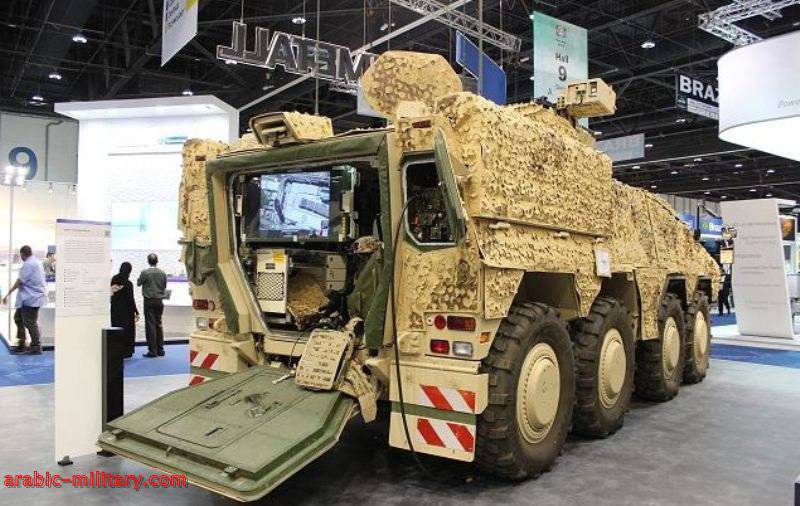
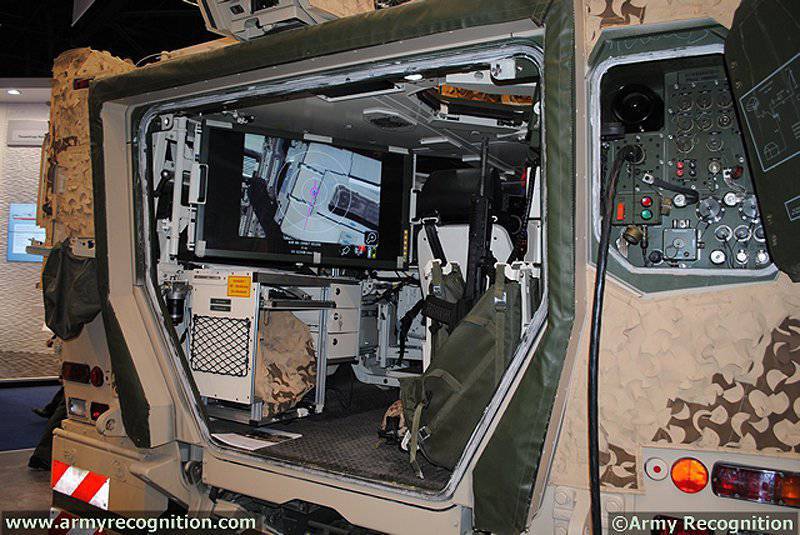
Rear view of the German Boxer car in the command post version. Production for Germany is nearing completion, while the Netherlands should start receiving the first production machines in 2014
German Boxer
The Boxer 8 × 8 was designed and manufactured by the joint venture Artec (between Rheinmetall MAN Military Vehicles and Krauss Maffei Wegmann). Machine from the middle of the year 2011 operated in Afghanistan. About 40 machines were deployed in three variants ordered by the Bundeswehr, namely GTFz A1, FüFz A1 and sgSanKfz A1. This is respectively the personnel transporter, commander and sanitary. As you can see, all the machines are in the designation A1, that is, they were all manufactured according to the latest standard, developed on the basis of the combat experience of the German army.
Although Artec cannot name all the improvements made, but some of them are available to the public. In particular, not only the angle of vertical guidance of the Dubrovnik Railway was increased in order to expand the field of view, but also the angle of inclination for firing at very short distances. Also, the interior compartments were repackaged for styling, as well as other minor modifications regarding storage areas. Changes in communications and security features remain classified. According to Artec, the A1 variant has a greater overall mass than the A0 variant, but the new numbers are not mentioned.
Short video of a military armored vehicle BOXER with my subtitles
Germany ordered the 125, 65 and 72 machines of the three options mentioned, production of the A0 variants was limited to 40, 16 and 7 machines, respectively. In June 2013 of the year were delivered 106 machines in the GTFz version, all commander and 16 sanitary; The fourth option, FahrSFz or a driving school, was also ordered and all 10 machines are already in use in Germany.
The Bundeswehr conducted environmental tests in Australia in 2010 before being sent to Afghanistan, and at the end of 2013 conducted tests in winter conditions in Norway. Based on the experience of Afghanistan, further upgrades of this machine are being considered, but the company is silent about it.
Another Boxer customer, the Dutch Army, received its first driving test car in August 2013. In total, 8 of such vehicles was ordered, plus 52 ambulances, 27 trucks, 60 command posts and 53 engineering, the Dutch use Boxer as a support vehicle. Deliveries of the first ambulance are scheduled for January 2014, while other options will start shipping from the 2015 year.
Artes is developing additional functional modules in order to take advantage of the modular design of the machine. In this case, only a module is being developed that is installed on a common chassis - the same for all variants.
New Lazar from Serbia
In 2013, Yugoimport showed its Lazar 2 8 × 8 multipurpose vehicle, which combines the protection capabilities of the Mrap with the advantages of a versatile vehicle regarding operational flexibility, in other words, it took into account the shortcomings of the original Lazar BTR. The steel case provides the basic ballistic protection of the 8808 Level, with additional reservations, the protection is increased to the 3 Level. The double bottom for protection against mines and VCA is left, the basic anti-mine protection in this case amounts to the 5a / b Level, but can be upgraded to the 2a / b Level. An innovative decision was made on access to the troop compartment: soldiers can disembark and disembark through two doors built into the aft ramp or lowering the ramp. All seats are now suspended from the ceiling, and in the troop compartment, they are folding. Ten people sit back to back and can observe the situation through large individual armored windows (wider than in the previous model). Marines can shoot from their weapons through the embrasures, five on board and one in each aft door, which allows you to have significant self-defense capabilities, for example in urban environments. The Lazar 2 BTR weighs 28 tons in combat gear, which is significantly more than the previous version, but is compensated by a more powerful engine located in front of the driver’s right. Independent suspension with progressive springs and hydraulic shock absorbers, central paging system is installed as standard. The Lazar 2 version of the BMP is equipped with a Yugoimport-SDPR UAB, armed with an 30-mm M86 automatic cannon and a paired 7,62-mm machine gun mounted above and behind the main weapon; Ammunition is 200 shells and 2000 ammunition, respectively. The maximum vertical angle of the gun is 60 °, the FCS consists of day / night sights and a laser rangefinder. The module can also take anti-tank missiles.
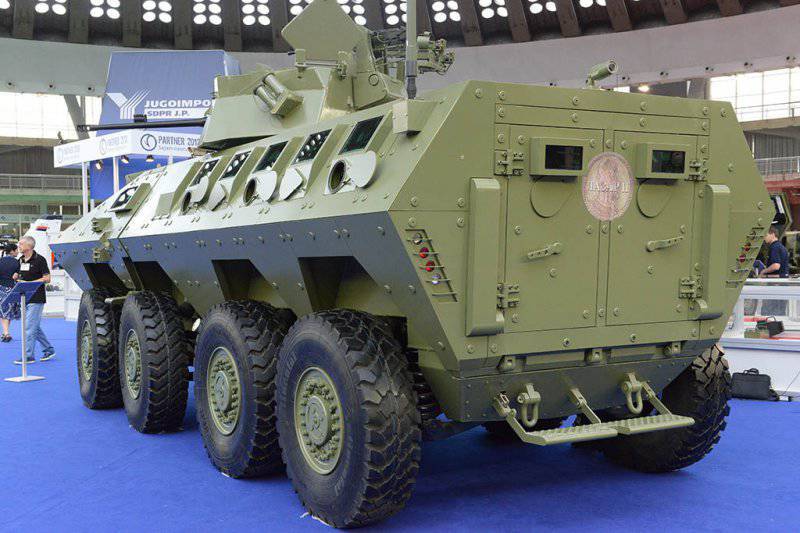
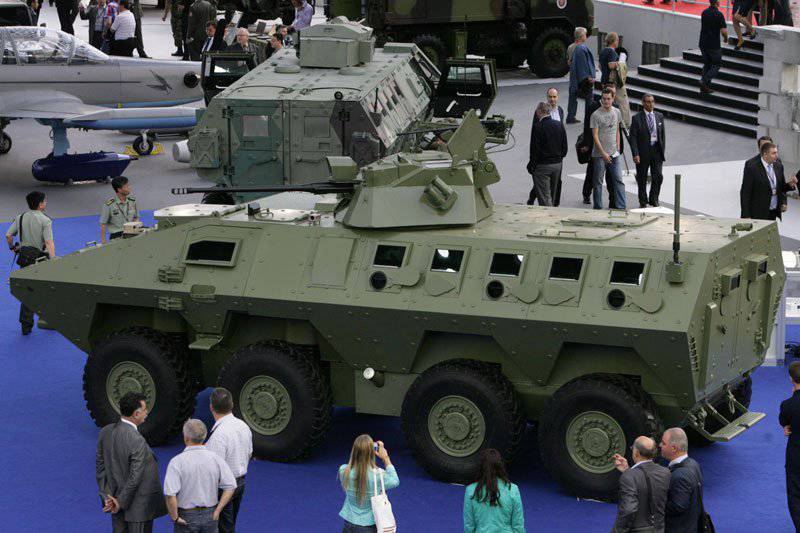
Two photos of the recently shown Baz Lazar 2, developed by Yugoimport. The car has been significantly upgraded compared to the previous model Lazar
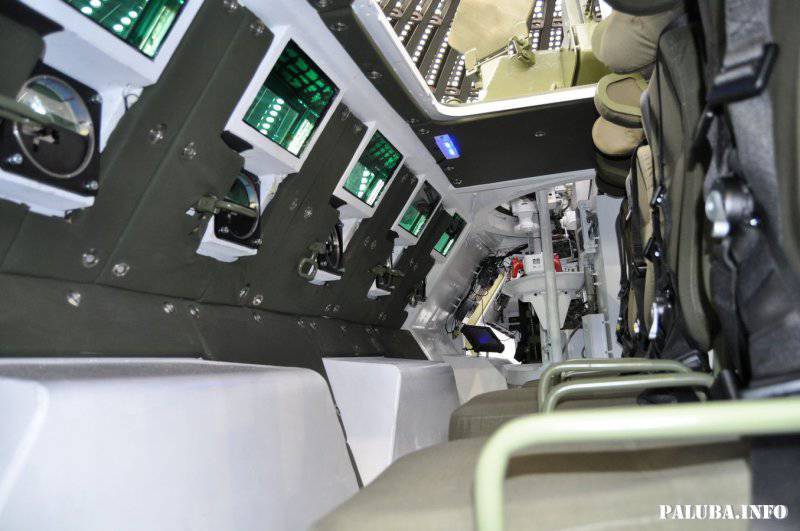
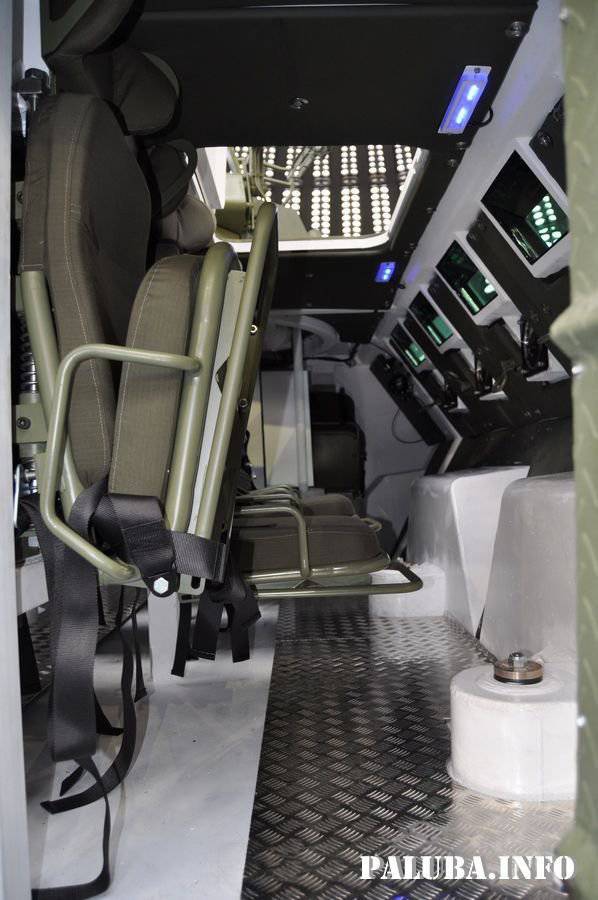
Inside the troop compartment Lazar 2; soldiers can conduct direct observation of the external situation and shoot from inside the car
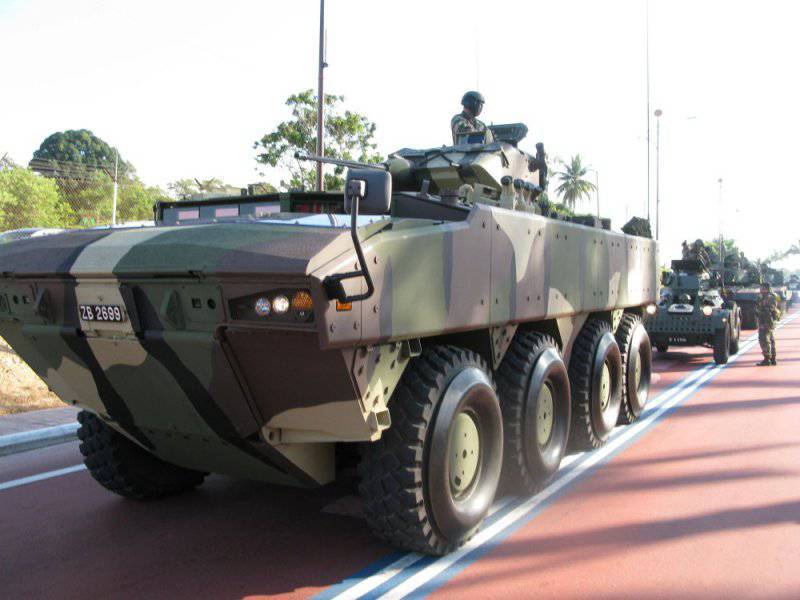
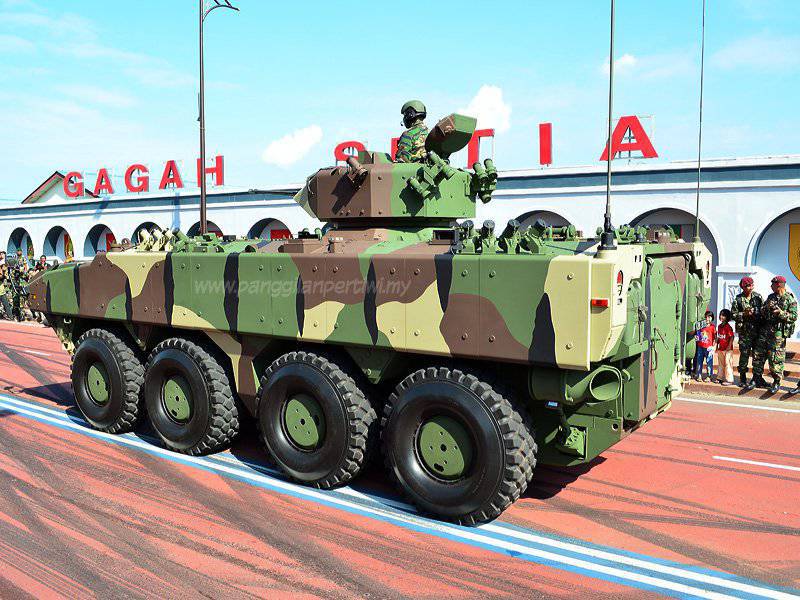
The AV-8 machine from the Malaysian company DefTech is based to a large extent on the Turkish FNSS PARS 8x8
Materials used:
Armada Compendium to 5 / 2013
www.patria.com
www.otomelara.it
www.nexter-group.fr
www.rheinmetall-defence.com
http://www.yugoimport.com
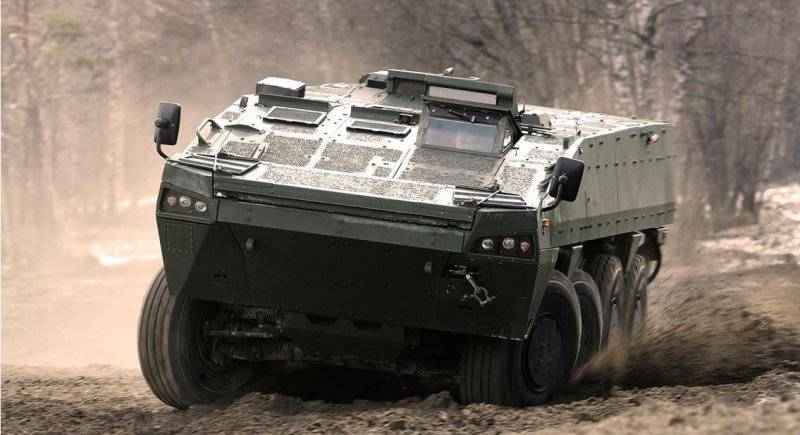
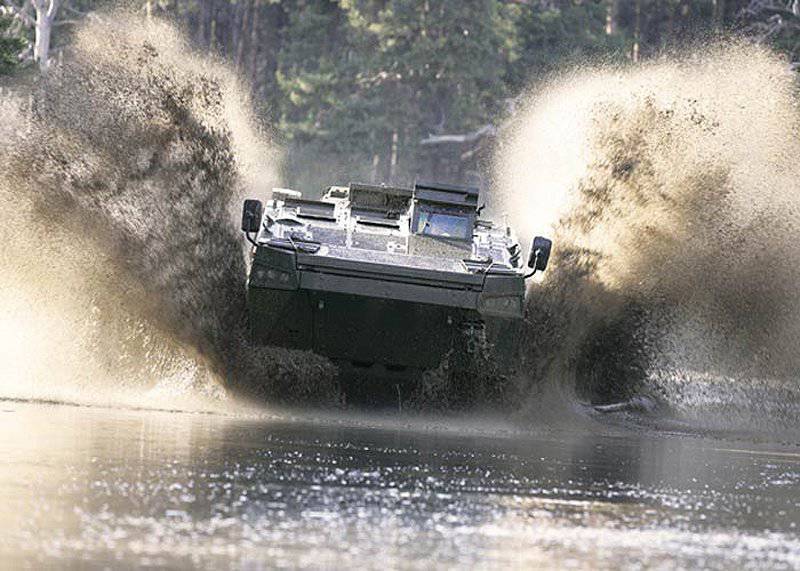
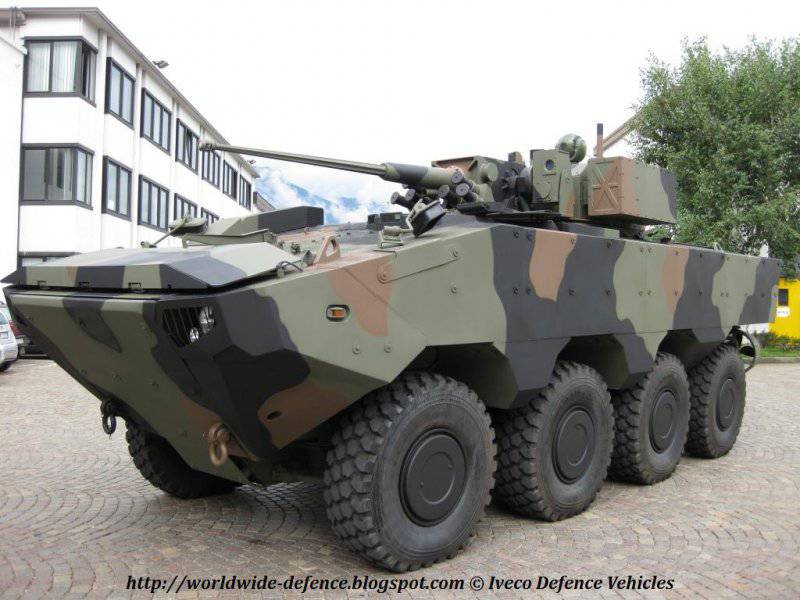
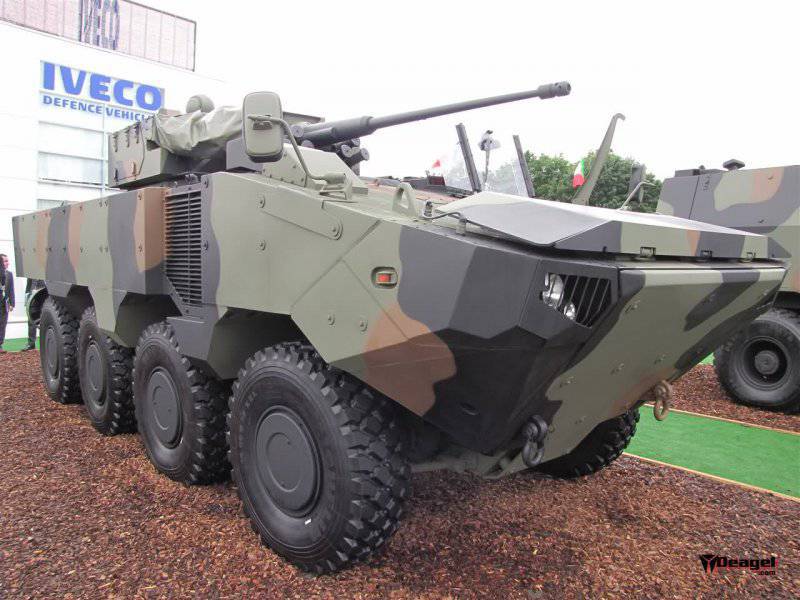
Information